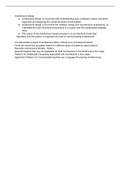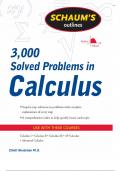Software Engineering (CSCI370)
Queens College
All 27 results
Sort by
Step by Step solutions to problem with complete explanations for every steps.

-
CSCI 370 Notes 27
- Class notes • 10 pages • 2022
-
- $2.99
- + learn more
The following notes discuss the programming system from object-oriented modeling and design, programming in the large, dependable programming, good practice guidelines for dependable programming, limiting the visibility of information in a program, checking all inputs for validity, and error-prone constructs including floating-point numbers, pointers, and dynamic memory allocation.

-
CSCI 370 Notes 25
- Class notes • 4 pages • 2022
-
- $2.99
- + learn more
The following notes discuss run-time partitioning of the partition by tasks, identifying those tasks, activity diagram, data flows, state diagrams, SW control, and processing units. In addition, it discusses architecture and system characteristics including performance, security, safety, availability, and maintainability. Moreover, it discusses the structure of the transaction processing applications and compiler components such as a lexical analyzer, symbol table, syntax analyzer, and a syntax...

-
CSCI370 Notes 24
- Class notes • 4 pages • 2022
-
- $2.99
- + learn more
The following notes discuss the process view from a conceptual or logical view, physical view from a process view, concurrency, subsystem allocation, UML sequence diagram, activity diagram, state diagram, entities, and the object-oriented modeling and design by Rumbaugh which contains information about system architecture.

-
CSCI 370 Notes 23
- Class notes • 4 pages • 2022
-
- $2.99
- + learn more
The following notes discuss the model-view-controller model, layered architecture pattern, organization of subsystems, high-level architecture of the weather system, repository architecture for an IDE, client-server architecture, and concurrency.

-
CSCI 370 Notes 22
- Class notes • 4 pages • 2022
-
- $2.99
- + learn more
The following notes discuss the model-view-controller model, layered architecture pattern, organization of subsystems, high-level architecture of the weather system, repository architecture for an IDE, client-server architecture, and concurrency.

-
CSCI370 Notes 21
- Class notes • 6 pages • 2022
-
- $2.99
- + learn more
The following notes discuss non-functional requirements including efficiency, maintainability, acceptability, and dependability. In addition, it discusses architectural views including logical conceptual, physical, process, and development. Moreover, it discusses interaction model, behavioral model, process pipe, filter pattern, view, development, physical view, process views, the Model-View-Controller (MVC), and layered architecture.

-
CSCI 370 Notes 20
- Class notes • 11 pages • 2022
-
- $2.99
- + learn more
The following notes discuss architectural design, architecture SDLC activity, reusable architectural models, general patterns, patterns for distributed computing, application patterns, etc. In addition, it discusses general architecture patterns including model view controller, layered, repository, pipe and filter, services, the main program, objects, and virtual machine. Moreover, it discusses distributed processing patterns including master-slave, 2-Tier client-server, multi-tier client-server...

-
CSCI370 Notes 18
- Class notes • 7 pages • 2022
-
- $2.99
- + learn more
The following notes discuss states and stimuli for the microwave oven including waiting, half power, full power, set time, disabled, enabled, and operation. In addition, it discusses structural diagrams, behavioral diagrams, data, activities, method calls, order processing, and context models.

-
CSCI370 Notes 17
- Class notes • 3 pages • 2022
-
- $2.99
- + learn more
The following notes discuss structural modeling, model by description, model by prescription, entities classes, behavioral models including event-driven and data-driven, activity models, state machine models, sequence diagrams, and interaction models.

That summary you just bought made someone very happy. Also get paid weekly? Sell your study resources on Stuvia! Discover all about earning on Stuvia



